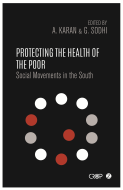Protecting the Health of the Poor: Social Movements in the South

This book collects essays on situations of health deprivation among the poor, with discussions of the social movements that have emerged to address this. The geographical cases span India, Colombia, Uganda, and Latin America. The situations described here are diverse, but a commonality is the low capacity – whether due to underfunding, discrimination or corruption – of public health systems.
The authors consider attention to health a moral imperative. There are clearly deep inequalities in health outcomes, even in high-income countries like the US. The book’s analyses unravel the layers of exclusion that keep poor people unhealthy, where “barriers to health are posed by microeconomic realities at the household level, the larger sociocultural context that influences decision-making behaviours, political and economic environments at a national level, and variable geopolitical conditions” (page 2).
If health is a right and a moral imperative, who is responsible for guaranteeing it? Poor governance and the politicization of health mean that governments are not always reliable in this regard. Civil society and intergovernmental organizations operate within country-level constraints. And the private sector may be complicit in damaging health, as discussed in the chapter on tobacco use among disadvantaged youths in India.
But the book is structured in such a way that one example of hope – represented by an organization, a campaign or an idea – follows each example of health deprivation. For instance, several chapters address the intellectual property regime for funding pharmaceutical innovation. The current model leads to deep inequalities. “The majority of health spending disproportionately benefits the wealthy”, many of whom are overusing medicines while “at least a third of the global population suffers from lack of regular access to essential medicines” (page 104). The irony, then, is that both poor people and wealthy people suffer from the imbalanced profit-based system of medicine development – even though the exclusion is clearly more severe than the over-privilege.
The analysis by Rossi Buenaventura and Restrepo Vélez explores how wealthy countries have used the international trade regime to limit lower-income countries’ access to medicines. For instance, through the US Trade Representative, the US can impose trade sanctions on countries that attempt to widen access to medicines. The expansion of patents to all medicines is a relatively recent development, and allows patents to be attached to products that bear little difference to existing ones. Also relatively new is the ability of publicly funded research organizations to license research results to private sector organizations.
These trends, along with the consolidation of massive pharmaceutical companies, have led to an explosion of research and development centred on profits and patents. And because increasing R&D has been accompanied by increasing data exclusivity and secrecy, it is difficult to know the level to which the costs of new drugs are inflated – or the level to which research results are being manipulated.
Clearly, the system is inefficient. Civil society organizations have stepped in to address the troubled relationship between pharmaceutical innovation and pricing. For example, in South America, the Alliance of NGOs for access to medicines is working with the Banco del Sur to develop a prize for innovative medicines for neglected diseases.
And in Colombia, civil society organizations working in public health have sought to apply a legal mechanism that would reduce the price of Kaletra, an antiretroviral drug used to treat HIV/AIDS. Their strategy centres on compulsory licensing, an antimonopoly mechanism whereby a patent owner relinquishes exclusivity rights in exchange for compensation. There are worldwide precedents for using compulsory licensing in the pharmaceutical sector. The civil society movement in Colombia has pointed to the differential pricing of Kaletra within Andean countries and the distortions of the patent system that allow monopolistic prices. While a compulsory licence for Kaletra has not yet been mandated by a Colombian court, the advocacy work has led to price control laws, actual price reductions, and a recognition of the Ministry of Health’s failure to uphold public health in relation to pharmaceutical pricing.
Other chapters describe civil society activities that are less about legal advocacy, and more about service provision and information dissemination. For instance, one chapter discusses the community-based interventions of the Indian NGO Swaasthya in the informal settlement of Malegaon, in Maharashtra. Swaasthya focused on maternal health among Malegaon’s poor after undertaking a review of community needs, knowledge and experiences. This led to capacity building with local healthcare providers as well as targeted communications with pregnant women. Swaasthya’s work has resulted in substantial increases in pregnant women’s registration for antenatal care and delivery at a healthcare facility.
These are just a few of the cases to draw out the links among poverty, development and health. Protecting the Health of the Poor argues that these three aspects are inextricably linked – and that addressing inequalities in this relationship is a matter of moral urgency.
Further reading:
Atkinson, Sarah J (1993), “Urban health in the Third World: a guide to the literature”, Environment and Urbanization Vol 5, No 1, pages 146–152, available at http://eau.sagepub.com/content/5/2.toc.
Stephens, Carolyn (2011), “Revisiting urban health and social inequalities: the devil is in the detail and the solution is in all of us”, Environment and Urbanization Vol 23, No 1, pages 29–40, available at http://eau.sagepub.com/content/23/1.
Book note prepared by Christine Ro
Search the Book notes database
Our Book notes database contains details and summaries of all the publications included in Book notes since 1993 - with details on how to obtain/download.
Use the search form above, or visit the Book notes landing page for more options and latest content.
For a searchable database for papers in Environment and Urbanization, go to http://eau.sagepub.com/

